Imagine turning your kitchen into a green haven where every meal helps the planet. You can make a difference by using sustainable cooking practices. These practices cut down on food waste and encourage eco-friendly habits.
Did you know Americans toss over 40% of their food? By choosing zero-waste cooking, you can cut down on this huge number. This way of cooking makes you think more about what you eat and waste. It helps you make eco-friendly recipe ideas that taste great and are good for the planet.
Changing a few things in your cooking can help the planet. It’s about being creative with what you have, cutting down on packaging, and planning meals better.
Key Takeaways
- Adopting zero-waste cooking can significantly reduce food waste.
- Sustainable cooking practices promote eco-friendly habits in the kitchen.
- Creating eco-friendly recipe ideas can be both fun and rewarding.
- Reducing food waste is a key step towards a greener kitchen.
- Simple changes to your cooking habits can make a big difference.
Understanding Zero-Waste Cooking Principles
Starting your zero-waste cooking journey means learning its core principles. It’s not just a cooking method. It’s a way of thinking that seeks to cut down waste and use all ingredients.
Zero-waste cooking is about being careful with what you buy. It makes sure you use every bit of it. This not only cuts down on waste but also sparks creativity in the kitchen.
What Does Zero-Waste Cooking Mean?
Zero-waste cooking is about using every part of an ingredient. It’s about being creative and resourceful with what you have. Chef Trisha Yearwood said, “The best thing about cooking is using everything and wasting nothing.” This idea is at the heart of zero-waste cooking.
By using zero-waste cooking, you help the planet and save money. You use ingredients that would have been thrown away.
The Benefits of Adopting a Zero-Waste Lifestyle
Starting with zero-waste cooking, a zero-waste lifestyle has many benefits. It helps the environment by reducing landfill waste and saves resources. It also makes you think more about what you buy, helping you spend less.
- Reduces kitchen waste and supports sustainable living
- Encourages creative cooking and meal planning
- Helps in saving money by utilizing every part of the ingredient
By choosing zero-waste cooking, you help make food systems more sustainable. Chef Dan Barber said, “The most important thing is to cook with the whole ingredient, to use every part of it.” This not only helps the planet but also makes cooking more enjoyable.
The Importance of Meal Planning
Planning your meals is essential for a waste-free kitchen. It helps save money and reduces your environmental impact. By planning ahead, you can avoid throwing away food and make your cooking more sustainable.
How Meal Planning Reduces Food Waste
Meal planning stops you from buying too much food. This way, you only get what you need. It also makes you use up all your ingredients, so nothing goes to waste.
Planning meals with what you already have helps you make a better grocery list. This keeps you from buying things you don’t need. It helps you avoid impulse purchases that might end up in the trash.
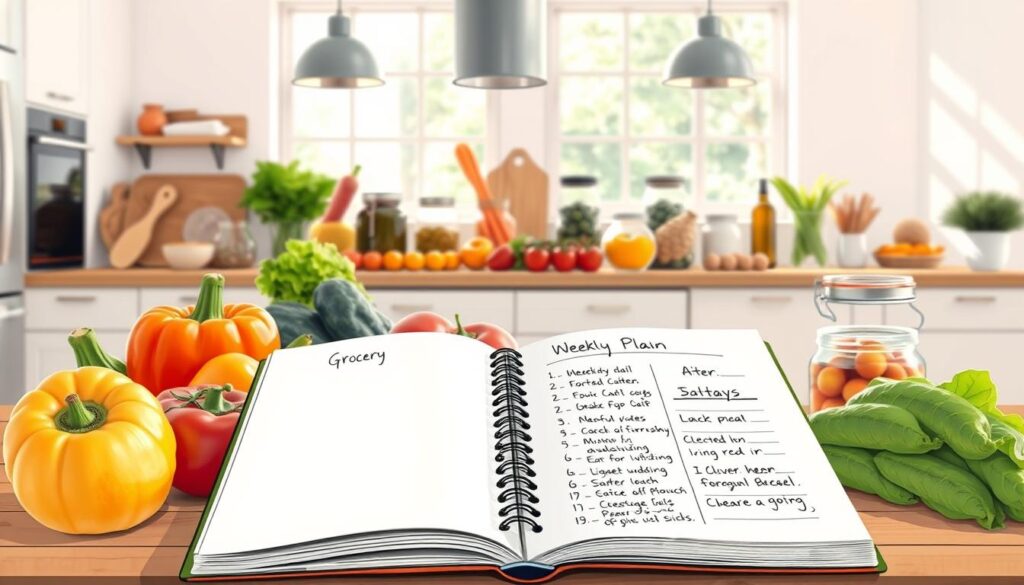
Tools for Effective Meal Planning
There are many tools to help with meal planning. You can use meal planning apps, kitchen inventory tools, and recipe organizers. These tools help you keep track of your ingredients and plan meals efficiently.
| Tool | Description | Benefits |
|---|---|---|
| Meal Planning Apps | Apps that help you plan meals and generate grocery lists. | Helps in organizing meals, reduces food waste, and saves time. |
| Kitchen Inventory Management Tools | Tools that help you keep track of the ingredients you have at home. | Ensures you use up all ingredients before they expire, reducing waste. |
| Recipe Organizers | Platforms where you can organize and save your favorite recipes. | Makes it easier to plan meals around ingredients you have, promoting zero-waste cooking. |
Using these tools in your meal planning can make your kitchen more sustainable. It helps reduce food waste and supports zero-waste cooking.
Smart Grocery Shopping Tips
Grocery shopping can help the environment with simple changes. By adopting smart habits, you can cut down on waste. This makes your lifestyle more sustainable.
Creating a Sustainable Grocery List
Start by planning your meals and making a list of ingredients. Stick to your list at the store to avoid impulse buys. This helps prevent waste.
Look at the packaging of your list items. Choose products with minimal or biodegradable packaging. Buying in bulk and unpackaged foods also reduces waste.
Choosing Bulk and Unpackaged Foods
Buying in bulk and choosing unpackaged foods cuts down on packaging waste. Many stores have bulk bins for items like grains and nuts. This saves money and reduces waste.
For produce, pick loose fruits and veggies instead of pre-packaged ones. This simple switch greatly reduces plastic waste.
| Food Item | Packaged | Unpackaged/Bulk |
|---|---|---|
| Nuts | Plastic bags or containers | Bulk bins |
| Dried Fruits | Pre-packaged bags or containers | Bulk bins |
| Grains | Boxes or bags | Bulk bins |
How to Support Local Farmers
Supporting local farmers makes grocery shopping more sustainable. They often use better practices and have shorter supply chains. This cuts down on carbon emissions.
Buying from local farmers gets you fresher produce. It also supports the local economy and reduces environmental impact.
Techniques for Food Preservation
Learning how to preserve food is a great way to cut down on waste. It lets you enjoy your favorite dishes for longer. This also means you don’t have to shop for groceries as often. It helps make your kitchen more sustainable.
Best Methods for Preserving Leftovers
Keeping leftovers fresh is easy. You can try a few methods:
- Refrigeration: Store leftovers in airtight containers to keep them fresh.
- Freezing: Freeze items like soups, meats, and vegetables for later use.
- Dehydrating: Remove moisture from foods to preserve them for longer periods.
These methods are simple and effective. They help you enjoy your meals while reducing waste.

How to Use Fermentation for Longer Shelf Life
Fermentation is a great way to keep food fresh longer. It also makes food taste better and is healthier. Here’s how to start with fermentation:
- Choose the right vegetables: Carrots, cabbage, and cucumbers are great starters.
- Create a brine: Use salt and water to create a brine that fosters beneficial bacteria.
- Monitor the process: Keep an eye on fermentation temperature and signs of spoilage.
Adding fermentation to your cooking can lead to delicious, environmentally conscious meals. It also helps reduce waste.
By following these minimal waste cooking tips, you can make a big difference. Techniques like fermentation and proper storage of leftovers are essential. They help reduce waste and make your kitchen more sustainable.
Creative Recipes That Use Food Scraps
Getting creative with food scraps can make your meals exciting and help the planet. Zero-waste cooking is about finding new flavors and techniques. It makes your cooking more fun and eco-friendly.
Start by thinking about what you usually throw away. You can turn vegetable scraps into tasty meals. Stale bread can become croutons or breadcrumbs.
Ideas for Vegetable Scraps
Vegetable scraps can be turned into many dishes. Here are some ideas to get you started:
- Make a flavorful carrot top pesto with carrot tops, garlic, nuts, Parmesan, and olive oil.
- Use broccoli stalks to make a tasty slaw. Peel and grate them, then mix with your favorite slaw dressing.
- Make a nutritious vegetable broth by simmering scraps like onion peels, celery leaves, and carrot ends in water.
These ideas reduce waste and add variety to your meals. You can also roast or sauté scraps to enhance their flavors.
Utilizing Bread Ends and Stale Breads
Bread ends and stale loaves can be used in many ways. Here are some creative ideas:
| Recipe | Description | Benefits |
|---|---|---|
| Croutons | Cube stale bread, toss with olive oil and seasonings, and bake until crispy. | Perfect for salads and soups. |
| Breadcrumbs | Blend stale bread into crumbs and use for coating chicken or fish before baking. | Healthier alternative to store-bought breadcrumbs. |
| Bread Pudding | Tear stale bread into pieces, mix with eggs, milk, and your choice of sweet or savory ingredients, and bake. | A delicious dessert or brunch option. |
By using these ideas, you’ll reduce waste and find new favorite recipes. The key is creativity and a willingness to try new things.
Composting: The Final Step in Waste Reduction
To really cut down on your environmental impact, adding composting to your routine is key. Composting turns food scraps into rich soil for your garden. It’s a great way to manage waste.
Composting not only cuts down on waste but also gives you a valuable resource for gardening. It’s a big part of sustainable kitchen habits. It makes sure food waste is handled in a green way.
How to Start Composting at Home
Starting a composting routine at home is easy. First, pick a spot in your yard or get a composting bin. It’s all about mixing “green” (like fruit peels) with “brown” (like dried leaves).
- Find a spot for your compost pile that’s well-ventilated and easy to get to.
- Start with brown materials at the bottom, then add green, and keep alternating.
- Turn the pile often to keep it aerated and speed up decomposition.
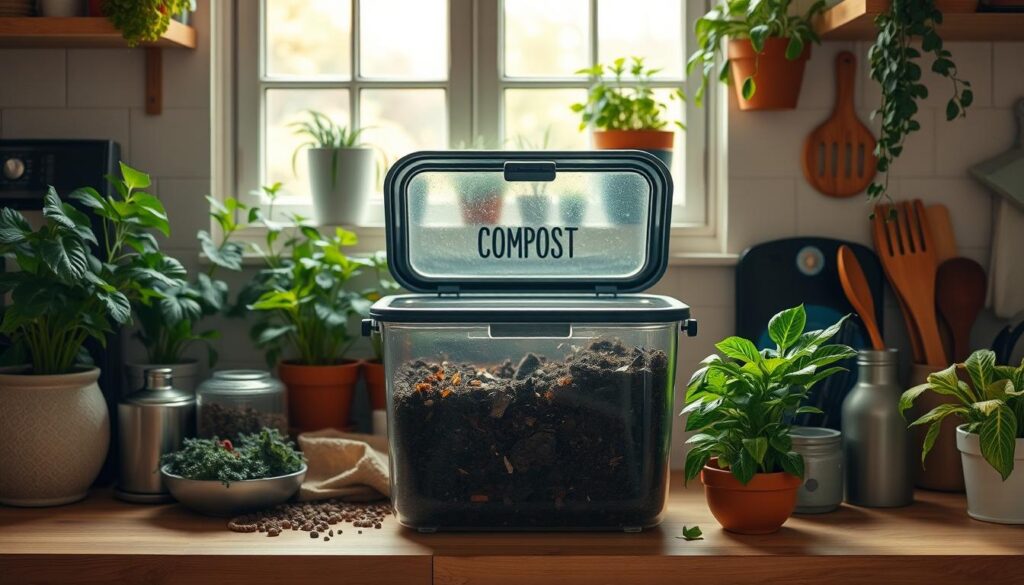
What to Compost and What to Avoid
Not everything can or should go into your compost. Knowing what to add and what to skip is important for a healthy pile.
Compost:
- Food scraps (fruits, veggies, tea bags, coffee grounds)
- Eggshells
- Yard trimmings
- Dried leaves
Avoid Composting:
- Meat, bones, and dairy (they attract pests)
- Pet waste
- Diseased or moldy stuff
- Weeds with seeds (they can grow in compost)
By following these tips, you can reduce food waste in the kitchen and help the planet. Composting is a simple yet powerful step towards a greener life.
Sustainable Cooking Techniques
Sustainable cooking is changing how we cook, making it greener and more efficient. Using one-pot recipes and batch cooking can cut down on waste and help the planet.
Embracing One-Pot Recipes
One-pot recipes are easy and eco-friendly. They need fewer ingredients and less energy. You can make many dishes, like stews and pasta, in just one pot.
Benefits of One-Pot Recipes:
- Reduced cleanup
- Less energy consumption
- Simplified meal preparation
“Cooking is not just about the food; it’s about the experience and the impact it has on our planet.”
Batch Cooking for Efficiency
Batch cooking means making lots of food at once. Then, you can heat it up as needed. It saves time and cuts down on waste by using all your ingredients.
Tips for Effective Batch Cooking:
- Plan your meals in advance to determine what to cook in bulk.
- Use appropriate storage containers to keep your cooked meals fresh.
- Label and date your stored meals for easy identification.
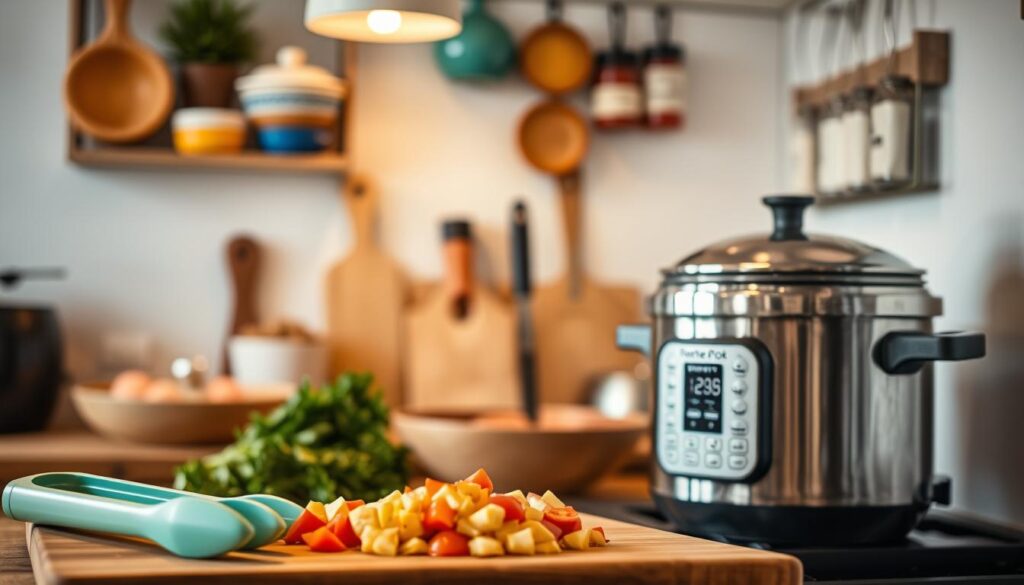
| Cooking Method | Energy Consumption | Waste Generation |
|---|---|---|
| One-Pot Recipes | Low | Minimal |
| Batch Cooking | Moderate | Reduced |
| Traditional Cooking | High | Significant |
Using one-pot recipes and batch cooking can help the environment. It also makes cooking more efficient.
Eco-Friendly Kitchen Tools and Utensils
Choosing eco-friendly kitchen tools is key to a sustainable kitchen. As you adopt zero-waste cooking, check your tools and utensils.
Using green kitchen tools cuts waste and improves cooking. Sustainable kitchen habits mean choosing wisely every day.
Essential Zero-Waste Kitchen Tools
Here are the must-have zero-waste kitchen tools:
- Reusable silicone spatulas
- Bamboo utensils
- Cast-iron cookware
- Stainless steel containers
These tools last long and cut down on single-use plastics.
“The simplest acts can have a profound impact when it comes to sustainability.”
“Sustainability is not just about doing the right thing for the environment; it’s also about creating a better future for ourselves and our communities.”
Where to Find Sustainable Utensils
You can find sustainable utensils online and at local stores. Here are some great places:
| Store | Product Range | Price Range |
|---|---|---|
| The Container Store | Reusable containers, utensils | $5-$50 |
| Sur La Table | Cookware, kitchen gadgets | $10-$100 |
| Thrive Market | Eco-friendly kitchen tools, sustainable living products | $5-$20 |

By picking eco-friendly tools, you help reduce waste. You also support environmentally conscious cooking.
Engaging Others in Zero-Waste Cooking
Getting your family and friends involved in zero-waste cooking is fun and rewarding. It makes sustainable living a shared adventure. By working together, you can make a bigger difference and build a supportive community.
Involving Your Family
To get your family on board, make it a fun team effort. Here are some tips:
- Make it a family affair: Get everyone involved in meal planning and grocery shopping. This helps them see the value of reducing waste.
- Assign tasks: Give each family member a role in cooking. It makes the process fun and interactive.
- Educate through cooking: Teach your family about sustainable cooking. Show them how to use leftovers and reduce food waste.
Hosting a Zero-Waste Cooking Party
Hosting a zero-waste cooking party is a great way to share your love for sustainable cooking. Here are some ideas to make it a hit:
- Plan a menu that uses zero-waste cooking methods. Use vegetable scraps to make a tasty broth.
- Use reusable utensils and containers to cut down on waste during the party.
- Make it interactive: Set up a cooking station where guests can help prepare a dish. It promotes waste-free cooking.
By sharing your passion for zero-waste cooking, you can inspire others. This can lead to a bigger positive impact on the environment.
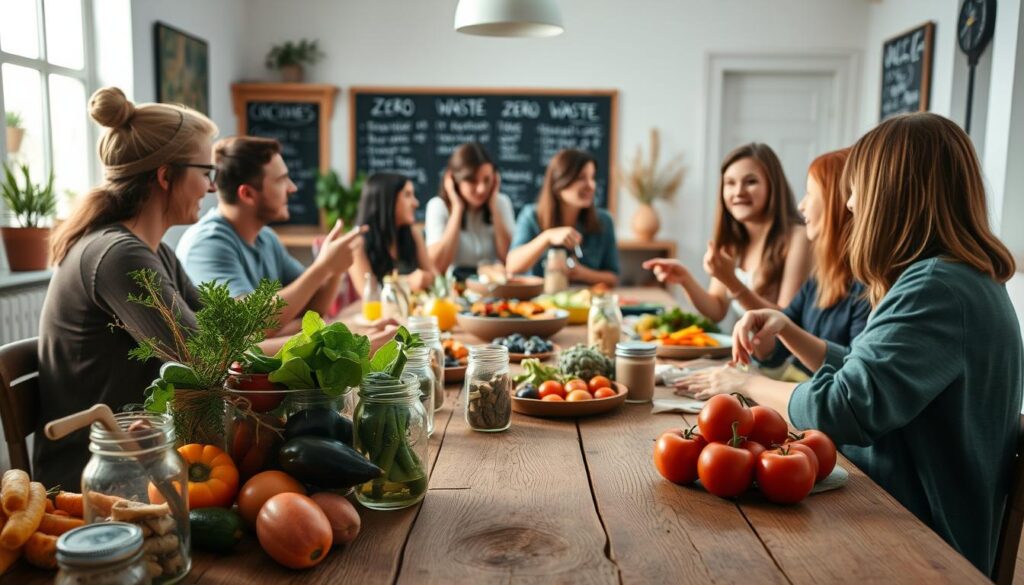
Reducing Single-Use Items in the Kitchen
Using fewer disposable kitchen items is key to eco-friendly cooking. Cutting down on single-use products greatly reduces kitchen waste.
Switching to reusable items is a big step. It cuts down on waste and keeps food fresh longer.
Alternatives to Plastic Wrap and Bags
There are many alternatives to plastic wrap and bags. Beeswax wraps, for example, are great for food wrapping. They’re reusable, eco-friendly, and last a long time.
Reusable silicone bags or containers are also good. They’re tough, easy to clean, and work for both hot and cold foods.
Using cloth napkins and towels instead of paper is another smart move. It greatly cuts down on paper waste.
Utilizing Reusable Containers
Reusable containers are essential for a green kitchen. They’re perfect for leftovers, lunches, and serving meals. Choose glass or stainless steel for their durability and safety.
Here are some tips for using reusable containers well:
- Look for containers with tight-fitting lids to keep food fresh.
- Label containers so you know what’s inside.
- Keep containers where you can easily find them to use them more.
Here’s a comparison of different reusable containers:
| Material | Durability | Non-Toxic |
|---|---|---|
| Glass | High | Yes |
| Stainless Steel | High | Yes |
| Silicone | Medium | Yes |

By adopting these habits, you can make your kitchen more eco-friendly. Start with small changes and work towards a greener kitchen.
Shopping for Sustainable Ingredients
Choosing the right ingredients is key to a greener kitchen. Buying sustainable ingredients helps support eco-friendly farming and cuts down on waste. By picking the right ingredients, you can make your kitchen more eco-friendly.
Understanding labels and certifications is vital for sustainable shopping.
Recognizing Certified Organic and Fair Trade Labels
Look for certified organic labels. They mean the products are free from harmful chemicals and GMOs. Fair Trade labels ensure fair pay and good working conditions for producers. These labels mean your ingredients are good for the planet and support fair practices.
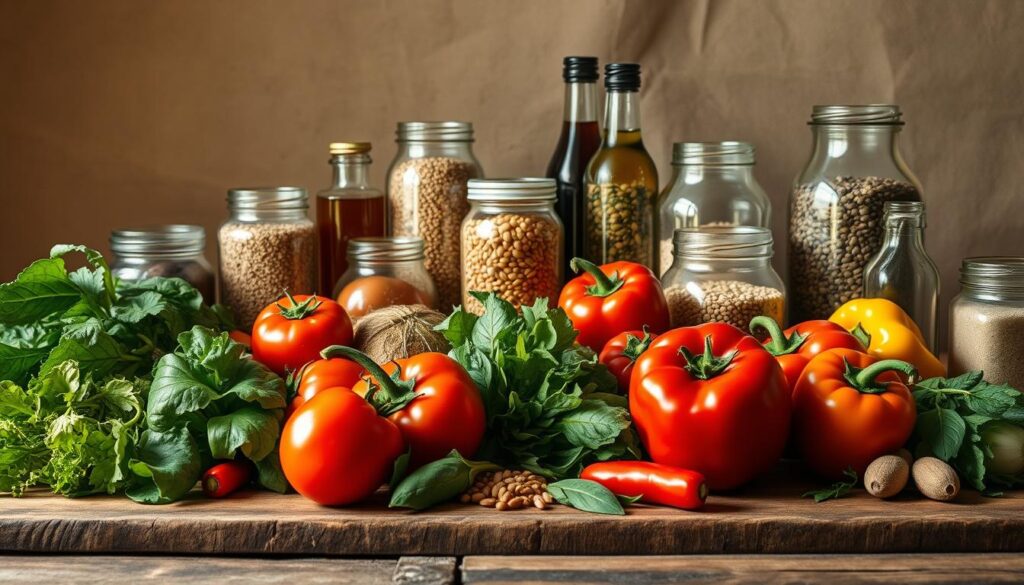
Seasonal Produce: What to Buy When
Buying seasonal produce is also important. In-season produce is fresher, tastes better, and is cheaper. It also helps reduce the need for resource-heavy out-of-season produce. Knowing what’s in season in your area is key.
- Spring: Asparagus, strawberries, spinach
- Summer: Tomatoes, zucchini, corn
- Autumn: Apples, squash, kale
- Winter: Root vegetables, citrus fruits, Brussels sprouts
The Role of Community in Zero-Waste Practices
Sharing your zero-waste kitchen journey with others makes it more fun and rewarding. Being part of a community boosts your efforts in sustainable kitchen habits. You’ll get helpful tips, insights, and motivation from others who share your goals.

Joining Local Zero-Waste Groups
Getting involved in local zero-waste groups is a great way to connect. These groups host workshops and cooking classes that focus on environmentally conscious cooking and waste-free cooking techniques. You’ll learn new skills, share your experiences, and meet others on a similar path.
Benefits of joining local zero-waste groups include:
- Access to a network of like-minded individuals who can offer support and advice.
- Opportunities to participate in community events and activities that promote sustainable living.
- A chance to share your own knowledge and experiences, helping to educate others about the importance of zero-waste practices.
Community Supported Agriculture and You
Engaging with your community through Community Supported Agriculture (CSA) programs is another great option. CSAs let you buy a share of a local farm’s produce regularly. This supports local farmers and gives you fresh, locally grown food.
Being part of a CSA helps you adopt more sustainable kitchen habits by:
- Encouraging you to cook with seasonal produce, reducing food waste and supporting local agriculture.
- Providing you with a variety of fresh ingredients, inspiring creativity in your cooking.
- Helping you connect with the people who grow your food, fostering a deeper appreciation for the effort and resources involved in producing it.
By embracing community involvement through local zero-waste groups and CSA programs, you can make your zero-waste journey more enjoyable, effective, and sustainable.
Continuing Your Zero-Waste Journey
As you keep moving towards a greener kitchen, it’s key to stay up-to-date with new trends in zero-waste cooking. Adopting sustainable cooking habits not only cuts down on waste. It also helps create a better world for our kids and grandkids.
Staying Current with Sustainable Living Trends
To keep your zero-waste cooking up-to-date, follow eco-friendly recipe ideas and blogs on sustainable living. You can also join workshops or online forums about sustainable cooking and food waste reduction.
Resources for Further Learning
Looking to learn more about zero-waste cooking? There are many resources out there. Check out books on sustainable living, take local cooking classes, or join groups focused on waste reduction. By learning more, you can keep improving your sustainable cooking ways.
FAQ
What is zero-waste cooking, and how does it contribute to a more sustainable kitchen?
How can meal planning help reduce food waste in the kitchen?
What are some effective ways to preserve food and reduce waste?
How can I get started with composting at home?
What are some eco-friendly kitchen tools and utensils that can help reduce waste?
How can I involve my family and friends in zero-waste cooking practices?
What are some alternatives to single-use items in the kitchen?
How can I shop for sustainable ingredients and support local farmers?
What is the role of community in promoting zero-waste practices?
How can I continue my zero-waste journey and stay updated on sustainable living trends?
Zero-Waste Carrot Top Pesto
Equipment
- Food processor
- Measuring cups and spoons
- Knife
- Airtight container
Ingredients
- 1 bunch carrot tops well washed, tough stems removed
- ½ cup nuts or seeds such as walnuts, almonds, or sunflower seeds
- 2 cloves garlic
- ½ cup olive oil
- ½ cup Parmesan cheese or nutritional yeast for vegan
- 1 tbsp lemon juice freshly squeezed
- to taste salt and pepper
Instructions
- Place carrot tops, nuts or seeds, and garlic in a food processor. Pulse until finely chopped.
- Add Parmesan cheese (or nutritional yeast), lemon juice, salt, and pepper. Pulse to combine.
- With the processor running, slowly drizzle in olive oil until the pesto reaches your desired consistency.
- Taste and adjust seasoning as needed. Serve immediately or store in an airtight container in the fridge for up to 1 week.

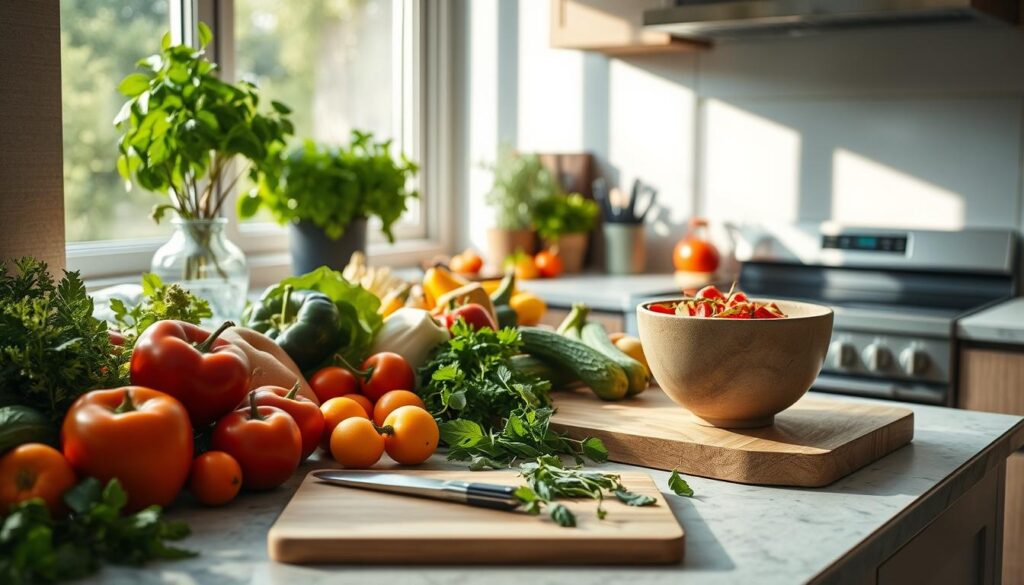
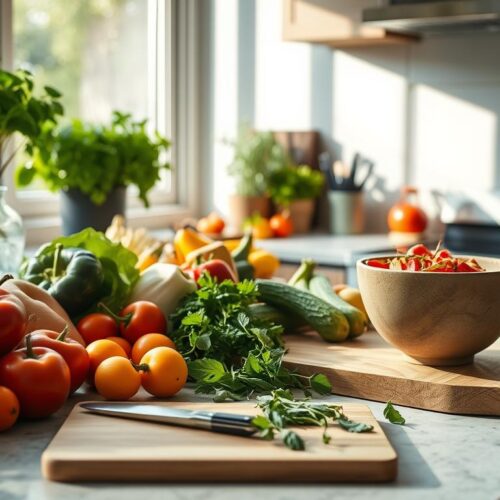
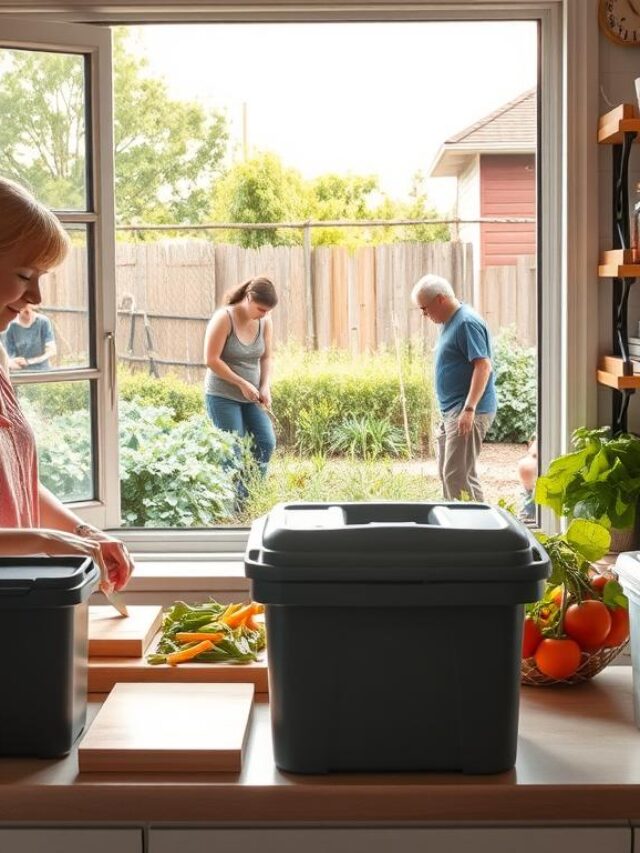

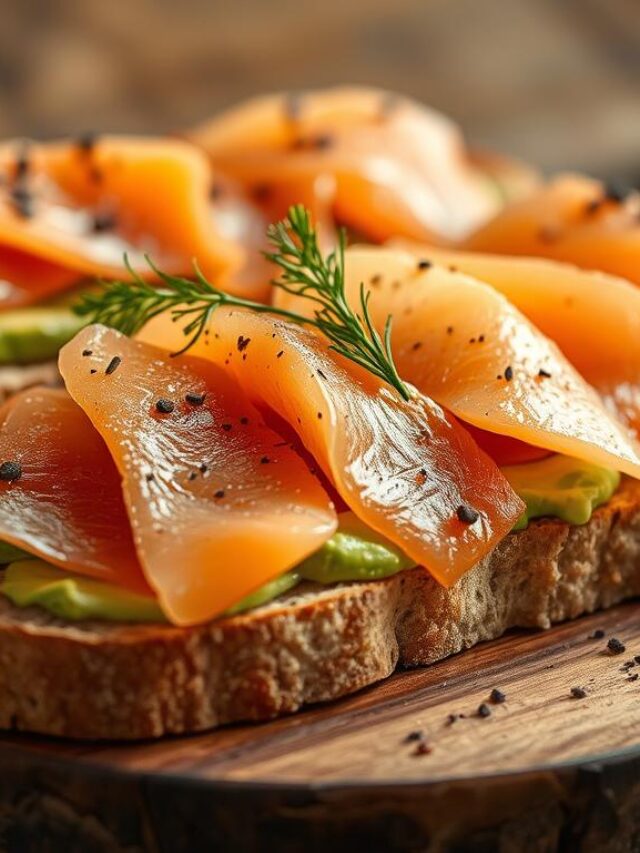


1 Comment